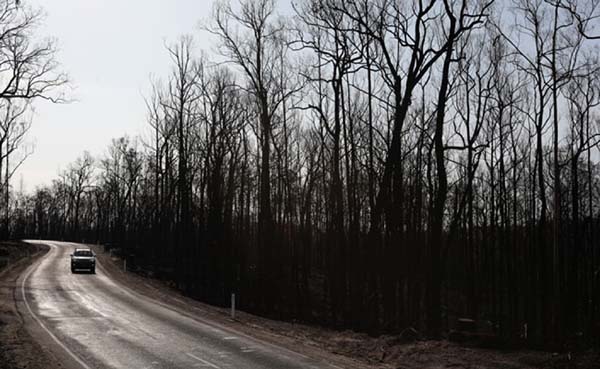
Reuters, Melbourne :
After months of destructive wildfires that have razed millions of hectares of land, Australia has been hit in recent weeks by wild weather that has alternately brought heavy downpours, hail storms, gusty winds and hot and dry air.
Severe bushfires burned through parts of Western Australia on Sunday, with other areas of the state dealing with the aftermath of a powerful cyclone, while the country’s east coast was facing potential life-threatening flash flooding.
After months of destructive wildfires that have razed millions of hectares of land, Australia has been hit in recent weeks by wild weather that has alternately brought heavy downpours, hail storms, gusty winds and hot and dry air.
About a dozen fires were burning in Western Australia (WA) on Sunday, with severe fire danger expected in several districts, according to fire services and the state’s Bureau of Meteorology.
New South Wales saw some areas drenched by the heaviest rainfall in almost 20 years by Saturday, with severe weather and flash flood warnings.
“Very hot over the Eucla (in WA) with a fresh and gusty southerly change extending from the west during the morning and afternoon,” the Bureau of Meteorology said on its website.
Daytime temperatures in the Eucla district were forecast at up to 42 Celsius (108 Fahrenheit).
The state’s upper parts were battling on Sunday the aftermath of a tropical cyclone Damien that made a landfall on Saturday afternoon, bringing gusty winds of up to 200 kilometres per hour (124 miles per hour).
No immediate damages were reported and the cyclone was expected to weaken as it moved inland, but winds were seen to blow at more than 100 kilometres per hour.
On the opposite coast of Australia, Sydney and the state of New South Wales were in danger of potential life-threatening flash flooding as rain kept bucketing down for a third day in a row in downpours not seen since 1998.
Rainfall in some parts of the state approached half the annual average, but the falls were welcomed after the state saw its driest year on record in 2019, at 55% below average.
The state’s Bureau of Meteorology said there was potential for heavy “rainfall and life-threatening flash-flooding,” and coast erosion, although little danger of river flooding as water levels have been low due to a persistent drought.
In Queensland, meteorologists also warned of flash and riverine flooding on Sunday, following heavy falls overnight.
Thai commandos kill rogue soldier who shot dead 26 people
A soldier who went on a shooting rampage in northeastern Thailand, killing at least 26 people, has been shot dead by security services after he holed himself up in a shopping centre.
Police and military sources told Reuters they had killed 32-year-old Jakrapanth Thomma on Sunday morning, a few hours after a failed raid on the Terminal 21 mall in Nakhon Ratchasima left one member of the security forces dead and two injured.The heavy rainfall across NSW and Victoria state on Feb. 7 was something of a welcome surprise after the Bureau of Meteorology’s three-month forecast issued in January forecast continued high temperatures and little rainfall.
Sydney alone was expected to receive as much as 130 millimetres of rain in the 24 hours to Feb. 8 morning, the biggest one-day rainfall since Feb. 5, 2002, data on the bureau’s website showed on Feb. 7.
“What we are broadly expecting over the next couple of days is this coastal trough to hang around, to keep delivering this widespread, prolonged, steady rainfall,” BOM forecaster Jane Golding said.
Fitzsimmons said he was optimistic the continued rainfall over the coming days would help firefighters in NSW get the 17 blazes that are still categorised as “uncontained” under control.
“We expect rainfall to continue to fall across a lot of these firegrounds and that will result in a number of those being declared contained and hopefully we will be confident we won’t see new ignitions from anywhere in those firegrounds,” he said.
Cyclone Damien
Some 3,500 kilometers to the northwest, a tropical cyclone was barreling toward the coast of Western Australia where it is expected to make landfall near Port Hedland, the world’s largest iron ore port, on Feb. 8.
Destructive wind gusts of up to 150 kilometres per hour could develop overnight on Feb. 7 night as the cyclone approaches the coast, and very destructive gusts of up to 230 kilometres per hour were expected when Cyclone Damien hits on Feb. 8, according to the Bureau of Meteorology.
Authorities said Port Hedland would be cleared ahead of the cyclone and the Dampier Port also closed.
Miners Rio Tinto and BHP Group said they were monitoring the situation and making preparations.
The wet weather prompted some light-hearted remarks at a visit by British Foreign Secretary Dominic Raab to the Sydney office of pharmaceutical giant AstraZeneca PLC.
“We are all very, very happy that you are here today, but also importantly that you’re bringing this fine British rain with you,” AstraZeneca CEO Pascal Soriot told guests.
“We really have brought the rain,” replied Raab.

